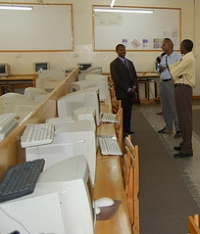Today there is great buzz as 30 teams of OLPCorps volunteers are fanning out across Africa to showcase hundreds of XO laptops to teachers and administrators in multiple rural schools. For the rest of the summer, there will be palatable excitement as educators have their own voyage of technology-assisted discovery. Next school year, children will jumping in joy when they are handed little green laptops to learn and explore with.
But what does the future look like? Five years from now, what will be the One Laptop Per Child legacy? Could Jesse's experience with laptops and appropriate technology be the norm?
I start the day as normal. This means waking up to no power and no water. That fine, I am prepared for this now and quickly wash down the bread I had baked the night before with the water I had presciently set aside. I journey to school where, in the half hour before classes start, I quickly outline my lectures for the day. [...]
Although the school is woefully ill equipped for labs, a smattering of grants and donations over the years has left the school with some surprising equipment. [...]
I was in the back of the room, trying to hold my breath because I had just accidentally kicked a box full of unlabeled white powder, when I saw a box of with a green cord protruding. Through a crack in the box I saw a green bevel and I was filled with disbelief. Yes!; it was a box with 15 pristine OLPC green laptops. The first thing I did, after doing a kick ass acid-base demo with color changing indicators, was spend the day playing with the laptops.[...]
I conspicuity took two laptops to the teacher room and started running loud attention grabbing programs. Within minutes every teacher was huddled behind my desk, taking excitedly about the laptops. Most teachers had never seen the laptops before and expressed disbelief that I had found them in the supply room.
I am not surprised that XO laptops were relegated to the storeroom, as Jesse's experience is not unique. Personally, I've seen too many school computer labs that are sealed off from use until the donor comes, when they're opened and filled with smiling, photographic children. But before you bemoan OLPC, understand why this happens.
In the usual donation context, communities are given an asset with great fanfare, and come to believe that if they safeguard the asset and show its still working when the donor returns, they'll get more assets. In this mindset, using the asset is dangerous - if its broken, the donor will be angry, might not fix it, and will surely not trust the community with any more assets.
One easy way to surmount this reasoning is to break the asset, and then show the community how to fix it. A harder, but more lasting way is to make a long-term commitment to the community around the asset. For OLPC that would mean a continuous volunteer presence at OLPCorps locations, a promise to return with more XO's and volunteers the next summer, and unlike their relationship with grassroots deployments, actually giving a damn about XO use in small pilots.




This, sadly, is not uncommon, even in the Western world.
"We got a grant, here's some new technology, have fun!" And then without any knowledge of how to use it, the technology sits unused.
I've even seen new highschools, with 30 computer lab in each hallway, plus a couple other labs for "technology courses". The technology labs would be frequently used for their scheduled courses, but I'd be surprised if the other labs were even used 1/10 the time. Maybe the odd class where the teacher tries to get students to do some research on the internet.
And of course within a few years the computers become obsolete. Even for low end, $500 computers, that's a lot of coin. Plus add in maintenance, power, etc. Enough to pay for another couple teachers.
This is documented in the book "The Flickering Mind".
I've said it before and I'll say it again, without an implementation strategy, teacher training, support, and proper infrastructure any purchase of technology is a complete waste.
When we hear of all the numbers of deployed computers, how many are sitting in store rooms?
In the usual donation context, communities are given an asset with great fanfare, and come to believe that if they safeguard the asset and show its still working when the donor returns, they'll get more assets. In this mindset, using the asset is dangerous - if its broken, the donor will be angry, might not fix it, and will surely not trust the community with any more assets.
And this is a cultural difference issue that must be addressed during implementation.